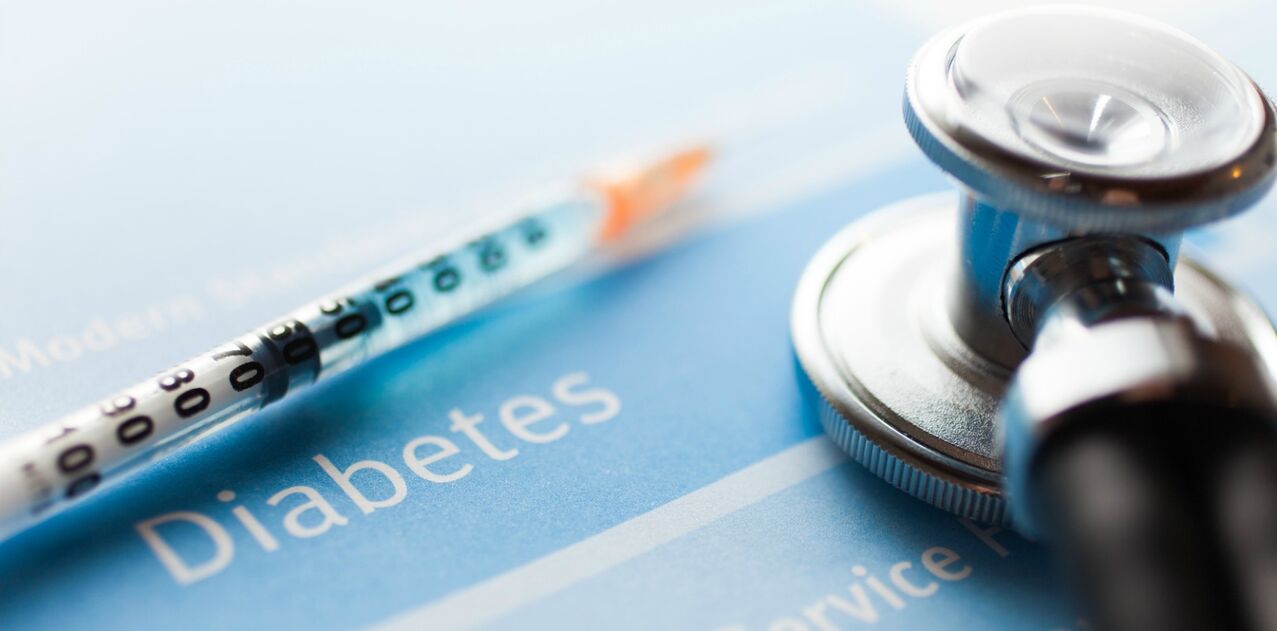Diagnosis of diabetes starts with identifying the main signs - symptoms. Although the clinical presentation of the disease is similar, each type of diabetes has its own specific characteristics.
About a thousand years ago, the ancient Egyptians described diabetes as a separate unit of disease. The diagnosis was then established by various methods, which are not used today due to their irrelevance. For example, Hippocrates told his patients that they had diabetes and that if the urine tasted sweet when tested, their clinic was bright. In traditional Chinese medicine, to diagnose this insidious disease, insects are used - flies, wasps, which sit on the container in which the urine is placed when the urine contains sugar.
Classification

Diabetes itself is a disease of the endocrine system. With it, the sugar concentration in the blood keeps rising due to various reasons. This is usually insulin deficiency and can be absolute or relative. This hormone is produced in beta cells located in the tail of the pancreas.
The result of this process is always a violation of metabolism at every level of the body, ultimately leading to a greater degree of serious complications of the cardiovascular and nervous systems, and less impact on the rest of the body's functional units.
To date, there are several types of diseases with completely different treatments. At the same time, no matter what the diabetes is, the clinical picture of the condition is almost always the same.
The most common classifications in the literature are:
- Absolute insulin deficiency diabetes is most common at a young age and in children. It's called the first category.
- Insulin-dependent diabetes occurs more often in adulthood and is characterized by a relative lack of insulin. Type 2 diabetes usually occurs in older people, but in some cases, the disease can also affect younger people. It is more common than the first, and a provocative factor in the pathology is being overweight.
- symptomatic. This disease can occur in the context of other pathological processes and is therefore also called secondary.
- Gestational diabetes that occurs during pregnancy. It usually goes away on its own after giving birth.
- If malnutrition, there will also be diseases such as diabetes.
It should be noted again that the first and second types of pathology are distinguished by the development of absolute and relative insulin deficiency, respectively. Therefore, it is the first disease that requires constant external administration of insulin. The need also arises when pancreatic failure is reached, especially in the setting of a longer course of type 2 diabetes.
For its part, the second disease can be characterized by the production of enough insulin, but the cells of the body are not sensitive to it for various reasons: the organelles responsible for this process may be blocked, or their numbers may not be sufficient to carry outeffective communication. As a result, the cells experience a sugar deficit, a signal to increase insulin production, but with little effect. As a result, the amount of insulin produced begins to drop, leading to an increase in blood sugar levels.
reason

The basis for the absolute insufficiency of insulin leading to the first diseases is an autoimmune process. It is caused by a violation of the immune system, which triggers the production of autoantibodies designed to fight the beta cells of the islets of Langerhans. This led to their destruction.
The main triggers for the destruction of the immune system and subsequent production of antibodies are usually various viral infections, the most aggressive of which may be rubella, chickenpox, mumps. The pathology is genetically predisposed.
It should be remembered that substances such as selenium increase the likelihood of a second pathology. But this is far from the most important factor in process development. These include the same genetic predisposition and the presence of being overweight. These factors should be considered in more detail.
- The higher the degree of obesity, the higher the risk of diabetes, and the third degree increases 10 times. Abdominal obesity, when fat deposits in the abdomen, can be the result of a metabolic disorder known as prediabetes.
- Genetic susceptibility suggests that this blood relationship increases the risk of diabetes several-fold. It does not matter whether an older or younger relative has the disorder. Sometimes there is a tendency for a disease to be passed down from generation to generation, but that's just a coincidence.
It should be noted that if diabetes is detected, the clinical development will be very slow and gradual, which can complicate the diagnosis in time.
Secondary diabetes usually develops in the context of the following processes:
- Organic lesions of the pancreas - impaired integrity due to inflammatory or neoplastic processes, trauma, resection.
- Other hormonal disorders - thyroid, adrenal, pituitary disorders.
- Toxic effects of drugs and other chemical agents.
- Changes in insulin sensitivity in the context of any pathological process.
- The patient has a genetic disorder.
Gestational diabetes and diabetes caused by malnutrition are somewhat different because they are reversible processes.
what happens to the body

For one or more of the reasons mentioned above, a process occurs in the body in which excess sugar in the form of glycogen ceases to be deposited in muscle tissue and in the liver. The sugar that the body cannot process continues in the blood, and only a small amount is excreted by the kidneys. This has extremely negative effects on all organs and systems of the body.
Since the glucose does not enter the cells, they begin to actively break down fat for energy. This leads to an increased formation of nitrogenous residues (ketone bodies), which disrupt all metabolic processes.
clinical picture
The most typical symptoms of pathologies that have not been diagnosed or that have markedly increased sugar may be:
- Excessive thirst, accompanied by dry mouth;
- Increased daytime and nighttime urination;
- General weakness, lethargy, fatigue, and heaviness in the muscles;
- a marked increase in appetite;
- itching of the skin and genitals;
- The wound surface heals for a long time;
- In type 1 diabetes, patients lose a lot of weight, while in type 2 diabetes they gain weight rapidly.
Typically, with the development of type 1 diabetes, clinical symptoms develop at lightning speed, while type 2 pathology is characterized by a progressive clinical worsening, sometimes symptoms can be fluctuating (alternating the normal state with the clinical manifestations of diabetes).
Complications of the disease

Both types of pathology are characterized by the development of complications that usually occur in the elderly. Diabetes also contributes to the early development of these diseases.
- Serious diseases of the cardiovascular system: atherosclerosis, ischemic diseases.
- Microvascular disease in lower extremities, kidneys, and eyes.
- Nervous system damage, manifested by dry skin, severe pain, and leg cramps, can reduce pain sensitivity.
- Vision loss.
- Impairs kidney function and increases protein excretion.
- Ulcerative defects develop in the feet, eventually leading to a necrotic and purulent process. It is based on the development of lower extremity neuropathy and vascular disease.
- Development of complications of skin infections - abscesses, fungal infections.
- High or low sugar coma may occur due to poor blood sugar control. Notably, hypoglycemia (low sugar) states are more difficult to treat than hyperglycemia (high sugar).
Sometimes with type 1 diabetes, health deteriorates and general weakness occurs. She may have abdominal pain until vomiting, and a taste of acetone in her mouth. These changes can be explained by the accumulation of ketone bodies, which must be removed from the blood as quickly as possible. If this does not happen, ketoacidosis coma occurs.
When insulin is overdose, coma may occur due to improper insulin doses. To prevent the development of any type of diabetic coma, you should constantly monitor your blood sugar levels and adequately choose your insulin dose.
diagnosis

Patients diagnosed with diabetes were managed by endocrinologists. Pathological diagnosis involves the following tests:
- Glucose curve analysis.
- Glucose tolerance test.
- The urine is analyzed for the presence of sugar and acetone, for which there are special test strips.
- A blood test for glycated hemoglobin, in healthy people, it never exceeds the norm.
- Determination of C-peptide, decreased in the first type of pathology. In the second case, it may stay within the normal range.
treat
To treat this process, patients need to:
- Stick to dietary recommendations. What they mean is to limit foods that contain fast carbohydrates. Diet should be reviewed, with priority given to five meals a day.
- Insulin therapy is indicated for patients with type 1 or secondary insulin-dependent diabetes mellitus. It is injected subcutaneously with a syringe or special syringe pen. Sometimes patients are fitted with insulin pumps. So far, development is underway for an artificial pancreas that itself can measure sugar and inject the right amount of insulin.
- The second disorder involves taking tablet hypoglycemic drugs.
- Special physiotherapy exercises are prescribed, as physical exercise helps to normalize blood sugar and helps fight obesity.
It must be remembered that this disease is treatable for life. The higher the patient's level of self-control, the fewer life-threatening complications the patient will experience, and their progression will be significantly slower.
























